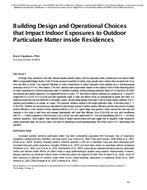Description
Although many associations have been observed between elevated outdoor airborne particulate matter concentrations and adverse healtheffects in large epidemiological studies, much of human exposure to particles of outdoor origin actually occurs indoors where we spend most of ourtime (and often at home). Two important influences on indoor concentrations of outdoor pollutants inside residences are (i) building envelopeconstruction and (ii) HVAC filter selection. This work describes recent experimental research on the impacts of both of these influencing factorson indoor concentrations of airborne particulate matter in residential buildings. Building envelope penetration factors (P) of submicron (20-1000nm) particles were recently measured in 19 single-family homes in Austin, TX that relied on natural infiltration for ventilation air. Values of Pranged from 0.17+/-0.03 to 0.72+/-0.08 and were significantly higher in older and leakier homes (as characterized by blower door tests). Anadditional experiment was also performed in the tightest, newest, net-zero-energy-capable home when it had an energy recovery ventilator (ERV)operating and connected to an outdoor air supply. This particular condition resulted in the largest penetration factor of the entire study: P =0.78+/-0.09. Therefore, the same home was responsible for both the least amount of outdoor particle infiltration and the most amount of outdoorparticle infiltration in this sample of homes, depending entirely on HVAC system design and operation. Indoor particle loss rates were alsomeasured in this study in each home and increased systematically with rated filter efficiency, from 0.92+/-0.46 per hour with low-efficiency(MERV < 5) filters installed to 1.09+/-0.60 and 2.32+/-1.03 per hour with medium (MERV 6-8) and high-efficiency (MERV greater than 10) filtersinstalled, respectively. Taken together, these measured values of outdoor particle sources and losses suggest that an occupant’s indoor exposure tooutdoor particulate matter can vary by a factor of at least 60, depending on building envelope design, filter choice, and HVAC system design andoperation.
Citation: IAQ Conference: IAQ 2013: Environmental Health in Low Energy Buildings
Product Details
- Published:
- 2013
- Number of Pages:
- 5
- File Size:
- 1 file , 390 KB
- Product Code(s):
- D-2013IAQConf-54




